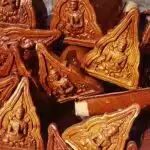As a grout float expert, I have seen numerous homeowners struggle with installing tiles and filling the gaps between the tiles with grout. Grouting is an essential step in tile installation that not only fills the gaps, but also helps to secure the tiles in place. However, many people overlook the importance of using proper grouting tools, especially grout floats.
Grout floats come in different shapes and sizes, each designed for specific tasks. They are essential for spreading and smoothing out grout between tiles without leaving any air pockets or gaps. In this article, we will explore how to use grout floats effectively and highlight different types that can be used for various purposes. With this knowledge, you can ensure that your tile installation looks professional and lasts for years to come.
What Are Grout Floats And Why Are They Important?
Grout floats are essential tools for any tiling project, and they are used to apply and spread grout between tiles. These tools come in different shapes and sizes, depending on the specific requirements of the project. They are made of materials like rubber, foam, or plastic, which make them durable and long-lasting.
One of the advantages of using grout floats is that they help to create an even layer of grout over tiles. This makes it easier to clean the surface after installation, as well as preventing cracks from forming due to uneven distribution. Additionally, grout floats can be used to apply different types of grouts such as sanded or unsanded.
There are different types of grout floats available in the market; each with its unique features and benefits. Some are designed for smaller projects while others for large-scale installations. The most common types include rubber float, sponge float, hard plastic float, and metal float. Choosing the right type is important because it determines the efficiency and effectiveness of your project. In the next section, we will discuss how to select the right grout float for your project based on your needs and preferences.
Choosing The Right Grout Float For Your Project
While some may argue that any grout float will do the job, it’s important to choose the right one for your project. Not all grout floats are created equal and selecting the proper material can make a significant difference in the outcome of your tiling project.
When choosing a grout float, consider the size of the tiles you’ll be working with. For larger tiles, you’ll want to use a float with a larger surface area to ensure adequate coverage and prevent air pockets from forming under the tile. On the other hand, smaller tiles require a smaller float to maneuver around tight spaces and avoid excess grout buildup.
Another factor to consider is the material of the grout float. The most common options are rubber, foam, and hard plastic. Rubber floats offer flexibility and work well for sanded grout applications. Foam floats are lightweight and ideal for non-sanded or epoxy grouts. Hard plastic floats are durable and best suited for large projects with heavy-duty grout materials.
Understanding how to choose the right grout float is essential in achieving a professional-looking finish on your tiling project. By considering tile size and choosing a suitable material, you can ensure an even distribution of grout that sets smoothly without blemishes or air pockets. In our next section, we will discuss basic techniques for using a grout float to achieve optimal results in your tiling endeavors.
The Basic Techniques For Using A Grout Float
After selecting the right grout float for your project, it is time to learn the basic techniques for using it. Grout floats are essential tools for spreading and pushing grout into tile joints. The first step is to mix the grout according to manufacturer recommendations. Once you have mixed the grout, scoop a generous amount onto the float’s edge and apply it diagonally across the joints.
To ensure that your grout float remains functional, proper maintenance is crucial. After each use, clean the float with water and soap to remove any remaining grout or debris. It is also important to inspect your float regularly for signs of wear and tear. Replace worn-out floats immediately to avoid compromising the quality of your work.
Advanced grout float techniques can also be employed once you have mastered the basics. One technique involves holding the float at a 45-degree angle while applying pressure to ensure that all spaces between tiles are filled with grout. Another technique involves gently tapping on top of the tile surface with the side of the float to remove any excess grout before wiping away with a sponge.
In conclusion, mastering grouting techniques takes practice, patience, and attention to detail. By following these tips on how to use a grout float properly, you can achieve professional-looking results in no time. However, before applying any grout, make sure that you know how to mix it correctly for best results.
How To Mix Grout For The Best Results
To achieve the best results when using grout floats, it’s essential to mix the grout properly. One of the most important factors in mixing grout is achieving the right consistency. The ideal consistency of grout should be similar to that of peanut butter. This way, it will be easy to work with and will set correctly.
One of the most common mistakes people make is adding too much water when mixing the grout. This can result in a runny mixture that is difficult to apply and may not set properly. It’s important to add water gradually until you have achieved the desired consistency. Another mistake that some people make is not mixing the grout thoroughly enough. It’s crucial to mix all ingredients evenly to ensure a consistent finish.
When mixing your grout, it’s also essential to follow the manufacturer’s instructions carefully. Different types of grouts may require varying amounts of water or different mixing times. Be sure to read and follow these instructions closely for best results.
To prepare your tiles for grouting, there are several steps you need to take before applying the mixed grout.
Preparing Your Tiles For Grouting
After mixing the grout to perfection, the next step is preparing your tiles for grouting. This involves tile cleaning and surface preparation. The goal of this step is to ensure that your tiles are free from any debris or dirt that may affect the overall quality of your grout installation.
Tile cleaning should be done using a soft-bristled brush and a neutral cleaner. Avoid using harsh chemicals or abrasive cleaners as they can damage your tiles. Once you have cleaned the tiles, allow them to dry completely before proceeding with surface preparation.
Surface preparation involves inspecting each tile for any irregularities such as cracks or chips. These should be fixed before applying grout to ensure a smooth and even finish. Additionally, it’s important to check that all tiles are level with one another. Any unevenness can cause lippage, which is when one tile protrudes higher than its neighboring tile.
Incorporated 3-item bullet point list:
- Use a soft-bristled brush and neutral cleaner for tile cleaning
- Inspect each tile for cracks or chips and fix them before applying grout
- Ensure that all tiles are level with one another
With clean and prepared tiles, it’s time to move on to applying grout with a float. This tool helps spread the mixture evenly across your tiled surface while ensuring that no air pockets remain trapped beneath the surface. In the next section, we’ll provide you with a detailed guide on how to use different types of grout floats effectively for best results.
Applying Grout With A Float: Step-By-Step Guide
Applying grout with a float is a relatively simple process that can provide beautiful results when done correctly. Before beginning, it is important to choose the appropriate type of grout float for your particular job. There are many different types of grout floats available on the market, so it’s important to select one that will work best for your specific project.
When choosing a grout float, consider the size and shape of the tiles you’ll be working with. For larger tiles, a large-format float may work best, while smaller tiles may require a smaller or more narrow float. Additionally, it’s important to consider the hardness of the grout you’ll be using. Harder grouts require stiffer floats in order to achieve proper coverage and compression.
Grout color choices can also impact the selection of your float. When working with darker colored grouts, it’s recommended to use a non-staining or non-discoloring rubber float to avoid staining your tiles. Conversely, white or light-colored grouts may benefit from using a plastic or metal float for optimal control and maneuverability. By selecting an appropriate grout float before beginning your project and avoiding common mistakes such as overloading or twisting during application, you can ensure lasting success in achieving beautiful finished results.
As with any tool used for construction projects, proper maintenance is key to ensuring long-term efficacy and longevity of use. To properly clean your grout floats after use, first remove any excess material from its surface using either water or a damp rag. Then carefully inspect the floats for any remaining residue before giving them a thorough scrubbing using warm water and mild soap if necessary. Avoid leaving cleaning agents on your floats for extended periods of time as this could damage the material over time leading to premature wear and tear which requires frequent replacement. With these easy steps you can keep your tools in top condition for future projects while enjoying their benefits for years to come!
How To Clean Your Grout Floats Properly
Picture this: you’ve spent hours carefully laying down tiles, and now it’s time to finish the job by filling in the gaps with grout. Your trusty grout float has served you well, but now it’s caked with grout residue and needs a good cleaning. Proper maintenance of your grout floats not only extends their lifespan but also ensures that they remain effective at their job.
Cleaning techniques for grout floats vary depending on the type of float you’re using. For rubber floats, mild soap and water are typically sufficient for cleaning. Simply rinse off any excess grout residue with warm water and then use a soft-bristled brush to gently scrub the surface with mild soap. On the other hand, if you’re using a sponge float, it’s important to avoid using soapy water as this can damage the sponge material. Instead, rinse off any excess grout residue with warm water and then use a clean cloth or sponge to wipe away any remaining debris.
In addition to regular cleaning, there are several maintenance tips that can help extend the lifespan of your grout floats. One essential tip is to always store your floats in a clean and dry area after each use. This helps prevent mold growth and keeps them in good condition for future use. Additionally, avoid leaving your floats submerged in water for extended periods of time as this can cause damage or deterioration to the materials used.
Transition: While proper cleaning techniques and maintenance tips go a long way in keeping your grout floats in good condition, there are still common mistakes that many users make when using these tools. In the next section, we’ll explore these mistakes and how to avoid them for optimal performance from your grout float.
Common Mistakes To Avoid When Using Grout Floats
After properly cleaning your grout floats, it’s important to know what techniques to avoid when using them in order to achieve the best results. One common mistake is applying too much pressure when spreading the grout. This can lead to an uneven application and potentially damage the surface of the tiles. Instead, use a light touch and let the float do most of the work.
Another technique to avoid is using a dry float. Grout needs moisture in order to properly adhere and fill in gaps between tiles. If your float is too dry, it can leave behind scratches or even pull out some of the grout you’ve already applied. Keep your float damp by dipping it in water before each use and wringing out any excess.
If you do encounter issues while using your grout float, there are troubleshooting tips that can help. For example, if you notice gaps or unevenness after applying the grout, try going over it again with a dampened float to smooth things out. You can also use a toothbrush or other small tool to remove any excess grout from corners or hard-to-reach areas.
Moving forward, let’s discuss how to use grout floats for tiles in hard-to-reach areas such as around electrical outlets or curved edges.
Grouting Tiles In Hard-To-Reach Areas
Grouting tiles in hard-to-reach areas can be a challenging task. As an expert in the field, I understand the frustration that comes with working in tight spaces. It is easy to make mistakes and end up with uneven grout lines or even damage your tiles. However, there are ways to make this process easier and more efficient.
One alternative to using a traditional grout float is a rubber grout float. This type of float is softer than its counterparts, making it easier to apply pressure in tight spaces without damaging the surrounding tiles. Additionally, you can use a smaller rubber float to get into those hard-to-reach areas without having to sacrifice precision.
Another option for grouting in tight spaces is using a grout bag. A grout bag allows you to apply the grout directly into the space without risking any damage or mess around the area. It’s also ideal for precise work since you have more control over how much grout comes out and where it goes.
Incorporating these alternatives into your tile installation process will not only save you time but also ensure that your final product has clean and professional-looking grout lines. In the next section, we will discuss how to use a grout bag for precision work and give tips on how to achieve flawless results every time.
Using A Grout Bag For Precision Work
Grouting tiles can be a daunting task, especially if you have to work on hard-to-reach areas. In the previous section, we discussed how to grout tiles in such challenging locations. Now let’s dive into precision grout work and the use of grout bags.
Precision grout work requires accuracy and attention to detail. Grout floats are an essential tool for this type of work as they allow you to apply grout in tight spaces and ensure that it is evenly distributed. There are different types of grout floats available on the market, including hard rubber floats, soft rubber floats, and foam floats. Each has its own advantages and disadvantages depending on the type of tile being installed.
Grout bags are another useful tool for precision grout work. They offer several advantages over traditional methods of applying grout. One benefit is that they allow you to apply grout exactly where it is needed without getting excess material all over the place. They also help prevent waste by allowing you to control how much material is dispensed at once. Additionally, using a bag allows you to avoid having to stop frequently to refill your float or trowel.
- Benefits of using a grout bag for precision work:
- Allows for more precise application
- Prevents waste
- Saves time by eliminating frequent refilling
- Reduces clean-up time
In conclusion, precision grout work requires careful attention to detail and the right tools for the job. Grouting with a bag offers several benefits over traditional methods, including more precise application, less waste, and time savings. When combined with a rubber float appropriate for your tile type, these tools can help make your next tiling project a success!
The Benefits Of Using A Rubber Grout Float
Rubber grout floats are an essential tool for anyone looking to complete a tiling job with precision and ease. The benefits of using a rubber grout float are numerous. For one, the soft and flexible rubber material allows for greater control and accuracy when filling in gaps between tiles. Additionally, rubber grout floats are versatile and can be used on both walls and floors.
When using a rubber grout float, it is important to ensure that the proper technique is employed. First, prepare the grout mixture according to manufacturer instructions. Then, using the flat edge of the float, spread the grout mixture over the tile surface at a 45-degree angle. Next, use the angled edge of the float to press the grout into the gaps between tiles, ensuring that they are completely filled. Finally, use a damp sponge or cloth to wipe away any excess grout from the tile surface.
In conclusion, rubber grout floats offer many benefits when completing a tiling job including greater control and accuracy when filling in gaps between tiles as well as versatility when working on both walls and floors. However, there may be instances where using a foam grout float may be more beneficial. In order to determine whether or not a foam grout float should be used instead of a rubber one will depend on several factors such as personal preference or specific job requirements.
When To Use A Foam Grout Float
- Prior to using a foam grout float, it is essential to properly prepare tiles by cleaning them, making sure they are level, and ensuring there are no gaps between the tiles.
- Applying grout with a foam grout float requires a gentle but firm pressure to ensure the grout is evenly spread and that all voids are filled.
- Adjusting and cleaning grout joints using a foam grout float should be done immediately after grout application as this will help to achieve a professional finish.
- To obtain a consistent finish, it is recommended to use a foam grout float in a back and forth motion, as well as at an angle in the corners, to work the grout into the joints.
- Once the grout has been applied, it should be allowed to set for the manufacturer’s recommended time before any wiping or cleaning is done.
- To achieve the final finish, a damp sponge should be used to remove excess grout from the tiles, before the grout is left to dry completely.
Preparing Tiles
The success of any grouting project relies heavily on the preparation of the tiles. Before applying grout, it is important to ensure that your tile layout is correct and that all tiles are level with one another. This not only ensures a smooth finish but also makes the grouting process easier. In addition, the surface of the tiles should be cleaned thoroughly to remove any dirt or debris that could interfere with adhesion.
Proper surface preparation is crucial in ensuring the longevity of your grout job. The tiles must be free from any dust or debris that may cause poor adhesion and uneven application. Use a soft brush to sweep off any loose particles and wipe down the surface with a damp cloth to remove any remaining residue. This will create an ideal surface for applying grout and ensure a professional finish.
As an expert in grouting, I cannot stress enough how important it is to prepare your tiles before using a foam grout float. Taking time to lay out your tiles properly and preparing their surfaces will make all the difference in achieving a high-quality finished product. Remember, always take care when working with tiling tools and equipment!
Applying Grout
Proper tile preparation is essential in achieving a successful grout job. Once the tiles are laid out and cleaned, it is time to apply the grout. The process of applying grout involves using a tool called a foam grout float, which helps spread the grout evenly across the tiles’ surface.
Using a foam grout float ensures that the grout is applied smoothly and no air pockets are left behind. It also prevents excess grout from filling up the spaces between tiles, which can lead to discoloration over time. It is important to work in small sections when applying the grout, starting from one corner and working your way across.
After applying the grout, it is crucial to seal it to prevent any discoloration or staining. This can be done by using a commercial sealer or by mixing water with an un-sanded tile grout until it forms a paste-like consistency. Apply this mixture over the dried grout, wait for it to dry, and then wipe away any excess residue. By following these steps, you can achieve a professional finish that will last for years to come.
Finishing Touches
When it comes to grouting, using a foam grout float is an essential tool to achieve a smooth and even finish. However, applying the grout with a foam grout float is just one part of the process. Finishing touches are equally important in ensuring that the grout job looks professional and lasts for years to come.
One finishing touch for grouting is using the right type of grout. There are different types of grouts available in the market, such as sanded and un-sanded ones. Sanded grouts are ideal for larger gaps between tiles, while un-sanded ones work better for smaller gaps. Choosing the right type of grout ensures that it adheres well to the tiles and doesn’t crack or discolor over time.
Another technique for finishing touches when working with tile is cleaning up excess residue after sealing. After applying a commercial sealer or an un-sanded tile grout mixture over the dried grout, wait for it to dry completely before wiping off any excess residue with a clean cloth. This step helps prevent any leftover residue from staining or discoloring the surface of the tiles.
By paying attention to these finishing touches, you can ensure that your tile project looks professional and stands the test of time. Whether you’re working on a bathroom renovation or installing new kitchen backsplash tiles, taking care in every step of the process will help you achieve excellent results that you can be proud of.
Using A Grout Float To Remove Excess Grout
After applying grout to the surface, it is important to remove any excess grout using a grout float. This tool is specifically designed for this purpose and comes in different types, such as rubber, foam, and hard plastic.
To use the grout float effectively, hold it at a 45-degree angle and press it firmly into the surface. Then, move the float diagonally across the tiles to remove any excess grout. It is important not to apply too much pressure as this can scratch or damage the tiles. Additionally, make sure to wipe off excess grout from the float regularly so that it does not build up and affect its effectiveness.
Removing grout stains and preventing grout haze are common problems that can be addressed by properly using a grout float. If there are stains on the surface after applying the grout, use a damp sponge or cloth to wipe them away before they dry out completely. In addition, prevent grout haze by consistently wiping off excess grout from the surface with a damp sponge during application.
In summary, a grout float is an essential tool for removing excess grout after application. Proper use of this tool can help prevent common problems such as staining and haze buildup on tile surfaces. In the next section, we will discuss troubleshooting common issues that may arise during the process of applying and using grouts.
Troubleshooting Common Grouting Problems
Grouting is an essential part of tile installation that requires precision and attention to detail. Even with the use of grout floats, problems can still arise during the process, leading to unsightly and potentially costly mistakes. Preventing discoloration is one common issue that can occur if not properly addressed. Discoloration often happens when grout comes into contact with water or other substances, resulting in stains on the grout lines. To avoid this problem, it’s important to seal the grout lines after they have cured fully. This will protect them from moisture and prevent any potential discoloration.
Another problem that may arise during grouting is dealing with uneven grout lines. Uneven lines can be caused by several factors, such as using too much or too little grout or not spreading it evenly across the tiles’ surface. One way to address this issue is by using a straight edge or level tool to ensure that all the tiles are level before applying the grout. Additionally, it’s important to remove any excess grout immediately after application to prevent buildup and unevenness.
To avoid further problems during the grouting process, here are some final tips for successful grout float use:
- Always mix your grout thoroughly before application.
- Use a back-and-forth motion when applying the grout rather than a circular one.
- Be sure to apply enough pressure when floating the grout to fill all gaps between tiles.
- Clean your float regularly during use to avoid unwanted buildup on its surface.
- Finally, be patient and take your time when working with grout – rushing through the process can lead to costly mistakes.
With these tips in mind, you can avoid common problems like uneven lines and discoloration while achieving professional-looking results every time.
Final Tips For Successful Grout Float Use
As we move on to the final tips for successful grout float use, it’s essential to note that there are various types of grout floats. However, all grout floats have a similar make-up, which includes a flat surface and a handle. The most common types of grout floats include rubber, foam, and epoxy. Each type has its unique properties that you must consider when making your selection.
One of the most significant benefits of practice is that it will help you develop a better understanding of how each type of grout float works. As such, you’ll be able to select the right tool for the job at hand. For instance, if you’re working with textured tiles or uneven surfaces, a rubber float may be more effective than an epoxy or foam float. In contrast, if you’re working with delicate tiles such as marble or glass tiles, an epoxy float would be more appropriate.
Another critical factor in ensuring successful grout float use is consistency. Consistency refers to the amount of pressure applied when using a grout float and the direction in which it’s applied. When applying pressure using your grout float, ensure that it’s consistent throughout the entire process. Additionally, ensure that you apply the same amount of force in each direction at all times. This way, your finished work will have an even appearance without any rough spots or unsightly lines.
| Type | Properties |
|---|---|
| Rubber Float | Ideal for textured surfaces due to its high abrasion resistance |
| Foam Float | Soft and absorbent material ideal for spreading sanded and non-sanded grouts |
| Epoxy Float | Sturdy and durable material suitable for spreading both sanded and non-sanded grouts |
In conclusion, mastering the art of using different types of grout floats requires patience and practice. It’s important to choose the right tool for each job based on factors such as tile texture and type. Additionally, maintaining consistency when applying pressure and direction is crucial in achieving a flawless finish with your grout float. By following these tips and utilizing the information provided in the table, you’ll be able to achieve successful grout float use every time.
Conclusion
In conclusion, grout floats are essential tools for any tiling project. As a grout float expert, I recommend selecting the right type of float for your specific project needs. Remember to mix your grout properly and prepare your tiles before applying the grout with smooth, even strokes using the float.
When in doubt, don’t hesitate to use a foam grout float for delicate surfaces or to remove excess grout. Troubleshooting common issues such as cracking or uneven application can be easily resolved with some patience and attention to detail. By following these basic techniques and tips, you can achieve professional-looking results with every grouting project. Remember: a little extra effort during the process can save time and money in the long run. So go ahead and dive into your next tiling project with confidence!
Image Credits
- “How I used the grout float.” by Vincent Ma (featured)





























